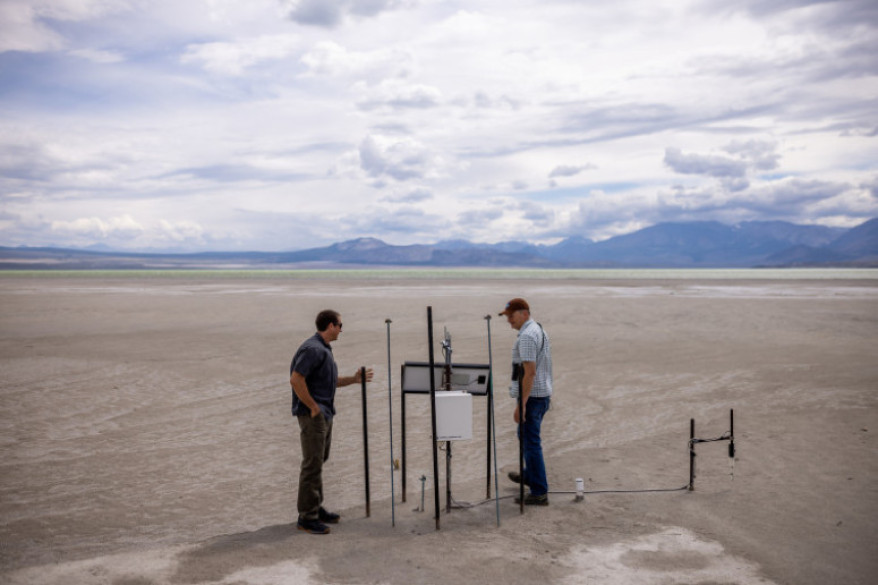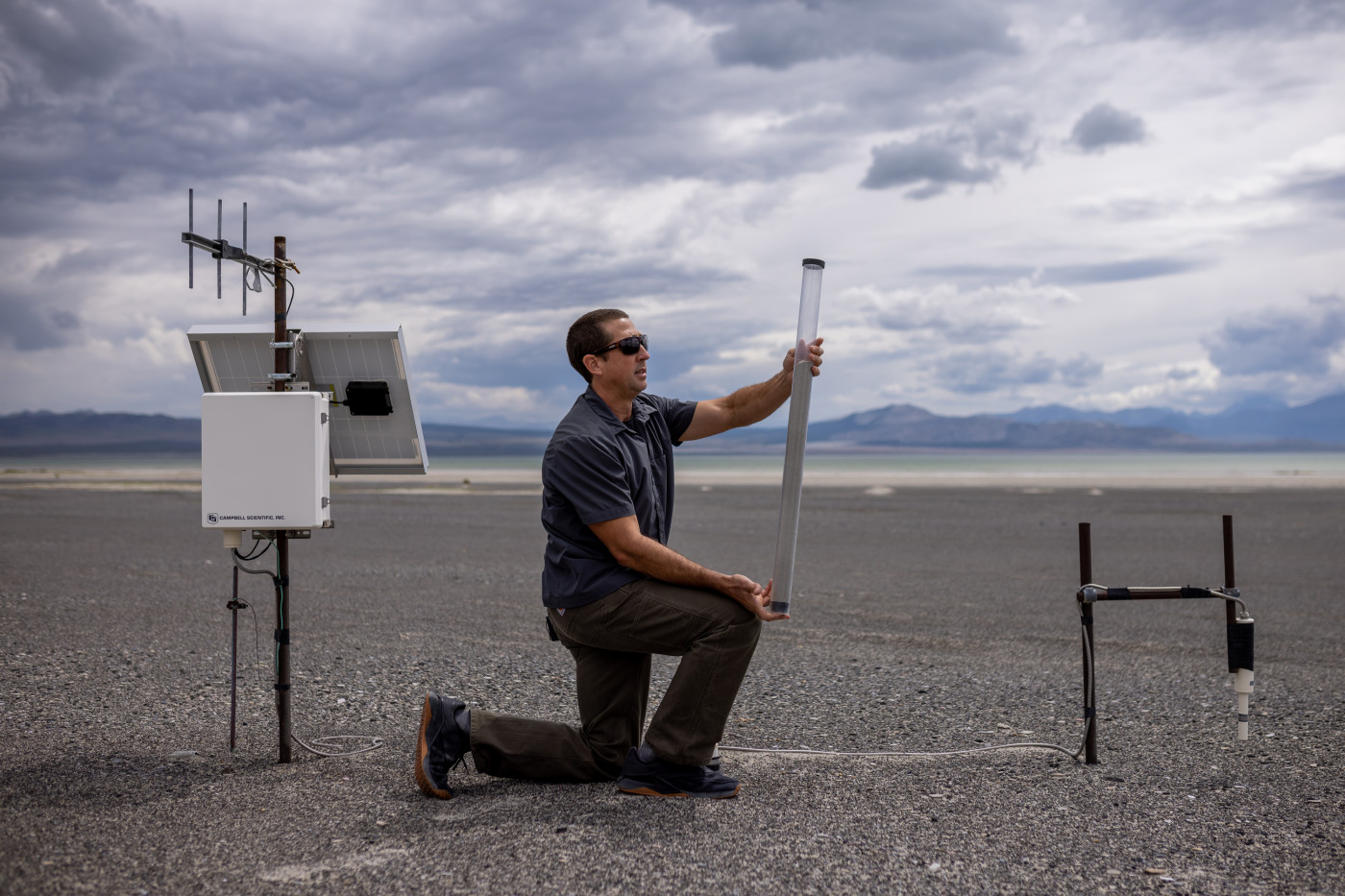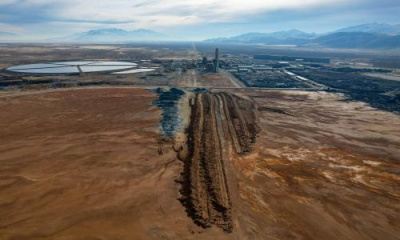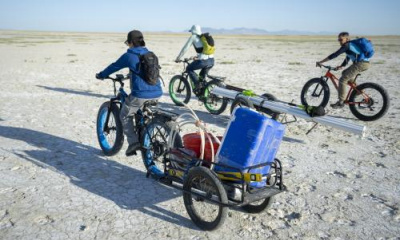Is Utah behind the curve when it comes to dust mitigation from the drying Great Salt Lake?
Owens Lake in California, once the nation’s largest source of dust pollution, has nine monitoring stations to determine the extent of the problem and help answer questions on what more needs to be done.
The Los Angeles Department of Water and Power siphoned the water back in 1913, and it wasn’t long after that it went bone dry.
Decades and $2.5 billion later, the dust is getting under control.
The Great Salt Lake story
Owens Lake is surrounded by those monitors that measure PM10 pollution, but in Utah there has not been that much regulatory focus on examining dust levels whipped up from the 800 square miles of exposed lakebed of the Great Salt Lake.
There have, however, been academic studies that point to the Great Salt Lake as a significant contributor of dust — as much as 30% — to the northern Wasatch Front. But a state regulatory authority like the Utah Division of Air Quality can’t manage what is not being actively measured.
House Speaker Brad Wilson, R-Kaysville, does not think the Great Salt Lake is at the point where it needs its own monitoring system or a regulatory authority — yet — but it could be coming if lake levels keep dropping.
“We're not putting any kind of special regulatory oversight of just the Great Salt Lake investment into it right now, but that doesn't mean it won't happen someday,” he said. “Personally, I don’t know if it makes sense right now, but more data, if lake levels continue to decline around the Great Salt Lake, that is going to be probably helpful.”
The conundrum of monitoring
Greg Carling, an associate professor in Brigham Young University’s Department of Geological Sciences, asserts more could be done via the Division of Air Quality or refined academic research when it comes to dust off the Great Salt Lake.
“We need monitors east and north of the lake because that is where the dust is going to come from these southerly winds,” he said. “I think that would be the prudent thing to do.”
The issue is whether the state wants to open the door to more regulatory oversight on pollution problems that are already a headache in other areas, like PM2.5, or fine particulate matter. What would it look like to invite extra controls?
Utah has been in compliance with PM10 regulations with the U.S. Environmental Protection Agency, but if it actively seeks to measure dust-born pollution from the Great Salt Lake or the dry Sevier Lake, that calls into question if more financial investment and federal oversight are necessary.
“I am not sure what kind of trouble the state would get itself into by making those measurements. That would be interesting to know,” said Carling, adding that researchers could take up that mantle as well.
He and other researchers are already actively engaged in a study, funded in part by the state, probing dust issues, the findings of which will be telling.
Carling said this summer has been the dustiest he and other researchers can recall since at least 2008 in the wake of the Milford Flats Fire.
“So those of us who have been looking at this the past 15 years or so are agreeing this has been the dustiest year that we can remember,” he said. “It seemed like in the spring or summer, we would have a dust event every week. Whereas in a typical year [it] might be just a few a year. … This year it seemed like it was twice that.”

Phill Kiddoo, air pollution control officer for the Great Basin Unified Air Pollution Control District, and Geoffrey McQuilkin, executive director of the Mono Lake Committee, check out an air quality monitor while taking journalists on a tour of the north shore of Mono Lake in Mono County, California, on Tuesday, Aug. 9, 2022. Spenser Heaps, Deseret News.
Utah’s pollution problems and the priorities
The Utah air monitoring network includes a station in west Salt Lake City’s Rose Park neighborhood, which is the closest, and another in Bountiful that measures PM10 pollution from a variety of sources.
Rich Mylott, regional spokesman for the EPA, said there are fewer PM10 sites operating in Utah as that pollution from human-made sources have dropped, and the required number of sites has decreased.
“EPA does not typically request that states shut down monitors,” Mylott said. “Any changes over time would be at the state’s discretion based on their evaluation of needs and resources, consistent with EPA review and approval.”
Bryce Bird, director of the Utah Division of Air Quality, said more proactive measures might be on the table in the future, but the menu has not yet been set for the Great Salt Lake.
“There needs to be more studies to understand the other source materials and mitigation that can be done to address it,” Bird said. “As far as the design of our regulatory monitors we're looking at assessing the impact to populations,” adding those monitors would have to reveal population being exposed.
Despite the wind and dust, Bird said the state did not violate PM10 standards, but has turned its attention to ozone and monitoring for fine particulate matter, or PM2.5 “And so the monitors that are located along the Wasatch Front are there to represent large populations,” Bird said, “and so if there was a large dust event, it would likely impact one of these regional monitors that is representative of the population being exposed.”
Rich Mylott, with the EPA, said dust monitoring from PM10 sources has dropped, as well in other areas.
“There are less PM10 sites operating in Utah as PM10 pollution levels from manmade sources have dropped, and the required number of sites has decreased. Several monitors are still in place across the state and operate as part of the state’s network to monitor for specific sources and natural dust and smoke events. I understand there are three in the Salt Lake City area, these would pick up a dust event from the Great Salt Lake.”
His agency’s priority is to directly monitor what it views as real threats to public health and coming into compliance with EPA regulations.
The threat
Bird said the top priorities for Utah are not for dust pollution, but for ozone and PM2.5, or fine particulate pollution, but that could very well change with the Great Salt Lake.
“We are actually seeing very few days right now that are impacted by the dust, but it has the potential to become worse over time. And our focus will likely need to shift at some point in the future. But right now we're more focused on the more immediate health impacts with ozone and PM2.5,” he said.
Mylott asserted, like Bird, that the dust could pose a problem, but it is not being measured to a great extent, begging the question of when?
What's your response to At Water's Edge?
Does this reporting project make you feel hopeful? Concerned? Inspired? Surprised?
Selected responses will be used on social media, on our website or in our newsletter.









